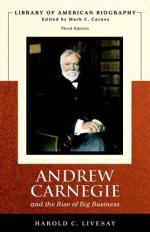|
This section contains 565 words (approx. 2 pages at 400 words per page) |

|
The Climb Ends Summary and Analysis
By 1898 Carnegie succeeds in the first stage of the steel industry securing raw materials and the second stage processing raw materials into steel with transportation systems and now plans stage three manufacturing finished items, like railroad cars and boilers. The other partners prefer collecting dividends to reinvesting them in 63 year-old Carnegie's new scheme. All partners are bound by the "Iron Clad Agreement" including the right to buy at book value the interest of a deceased partner, that a two-thirds vote can force a partner to sell at book value and that retiring partners can sell at book value to be paid in installments. Carnegie protects the firm from a forced sale to pay 58 percent to his heirs at death but also disallows any outsiders to acquire an interest. The sale price is based on a book value...
(read more from the The Climb Ends Summary)
|
This section contains 565 words (approx. 2 pages at 400 words per page) |

|




